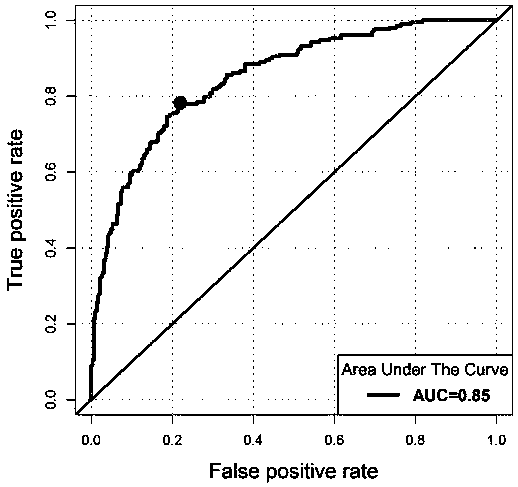SNP marker composition related to brain radiation injury caused by radiotherapy and application thereof
A radioactive brain injury and marker technology, applied in the fields of genetic engineering and oncology, can solve problems such as unreported
- Summary
- Abstract
- Description
- Claims
- Application Information
AI Technical Summary
Problems solved by technology
Method used
Image
Examples
Embodiment 1
[0138] Example 1 Screening of SNP markers
[0139] 1. Collection of samples and collation of data
[0140] From 2005 to 2007, a large number of blood samples were collected from the Biobank of Sun Yat-Sen University Cancer Hospital. After sorting out the sample information, 1082 samples that met the following criteria were selected for genome-wide microarray scanning:
[0141] Inclusion criteria:
[0142] (1) Nasopharyngeal carcinoma patients with clear pathological diagnosis and clinical stage;
[0143] (2) The expected survival is greater than 6 months;
[0144] (3) Functional status score (KPS) ≥ 70 points;
[0145] (4) Age 18-80 years old;
[0146] (5) Have complete medical records (medical history, physical examination, related examinations, previous treatments);
[0147] (6) Complete radiation therapy and conduct regular MR image review;
[0148] (7) Participate voluntarily and sign the informed consent form.
[0149] At the same time, patients with any of the follo...
Embodiment 2
[0173] Example 2 TaqMan (Applied Biosystems) genotyping detection of a single SNP
[0174] The loci associated with radiation-induced brain injury found in Example 1 through whole-genome scanning were detected and verified in the original sample, and the Sequenom MassARRAY genotyping method was used. The specific steps were as follows:
[0175] 1. The specific steps are:
[0176] (1) Collect 3 mL of peripheral venous blood with an EDTA anticoagulant tube, centrifuge at 3500 r / min for 10 minutes, and then aspirate the plasma.
[0177] (2) Remove red blood cells: add an equal volume of red blood cell lysate (10 mmol / L TrispH7.6; 5 mmol / L MgCl 2 ; 10 mmol / L NaCl), mix well by inverting up and down, centrifuge at 4000r / min for 10 minutes, and discard the supernatant. Then add 5 mL of erythrocyte lysate, mix well by inverting up and down, centrifuge at 4000r / min for 10 minutes, and discard the supernatant.
[0178] (3) Lyse nucleated cells: add 1mL leukocyte lysate (50mmol / L Tri...
Embodiment 3
[0201] Example 3 Kit for Predicting the Risk of Radiation Brain Injury Caused by Tumor Radiotherapy
[0202] The production and operation process of the SNP kit is based on the Sequenom MassARRAY genotyping detection technology.
[0203] 1. The kit contains specific amplification primers and specific extension primers for 15 SNPs:
[0204] The amplification primer sequence of rs1501803 is SEQ ID No: 1-2;
[0205] The amplification primer sequence of rs13166368 is SEQ ID No: 4-5;
[0206] The amplification primer sequence of rs2295767 is SEQ ID No: 7-8;
[0207] The amplification primer sequence of rs6977424 is SEQ ID No: 10-11;
[0208] The amplification primer sequence of rs6988369 is SEQ ID No: 13-14;
[0209] The amplification primer sequence of rs1173107 is SEQ ID No: 16-17;
[0210] The amplification primer sequence of rs1410079 is SEQ ID No: 19-20;
[0211] The amplification primer sequence of rs11017797 is SEQ ID No: 22-23;
[0212] The amplification primer seque...
PUM
 Login to View More
Login to View More Abstract
Description
Claims
Application Information
 Login to View More
Login to View More - R&D
- Intellectual Property
- Life Sciences
- Materials
- Tech Scout
- Unparalleled Data Quality
- Higher Quality Content
- 60% Fewer Hallucinations
Browse by: Latest US Patents, China's latest patents, Technical Efficacy Thesaurus, Application Domain, Technology Topic, Popular Technical Reports.
© 2025 PatSnap. All rights reserved.Legal|Privacy policy|Modern Slavery Act Transparency Statement|Sitemap|About US| Contact US: help@patsnap.com



